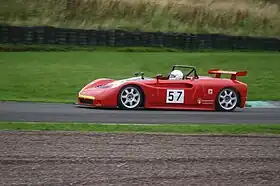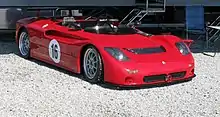| Maserati Barchetta | |
|---|---|
 | |
| Overview | |
| Manufacturer | Maserati |
| Also called | Barchetta Corsa (racing) Barchetta Stradale (road) one unit only |
| Production | 1991–1992 (17 units produced) |
| Designer | Carlo Gaino at Synthesis Design[1] |
| Body and chassis | |
| Class | Racing car |
| Body style | 2-door speedster |
| Related | De Tomaso Guarà Maserati Biturbo |
| Powertrain | |
| Engine | 2.0 L (1,996 cc) 90°, 24-valve twin-turbocharged AM501 V6 |
| Transmission | 6-speed ZF manual |
| Dimensions | |
| Wheelbase | 2,600 mm (100 in) |
| Length | 4,050 mm (159 in) |
| Width | 1,965 mm (77.4 in) |
| Height | 930 mm (37 in) |
| Curb weight | 775 kg (1,709 lb) |
The Maserati Barchetta is a mid-engine racing car,[2] like the 350 and 450S, that was designed by Carlo Gaino[3][4] of the Synthesis Design,[5] an Italian design house.
The Barchetta was designed and developed for the one-make racing series Grantrofeo Barchetta[6] which was held 1992 and 1993 throughout Italy and Europe. It featured sixteen races in total, most of them in Italy. The Barchetta had a backbone chassis made of aluminium which was unusual for a Maserati automobile for a time considering that the cars offered by Maserati had a steel unibody construction. It had a Formula 1 suspension geometry and body panels made of carbon fibre which resulted in a total weight of 775 kg (1,709 lb). The Barchetta was one of the last Maserati models built under De Tomaso ownership.[7]

16 examples of the racing model[8] were produced by hand at the De Tomaso factory in Modena, plus two prototypes (one racing-corsa, one street-stradale model). It featured a mid-mounted Maserati AM501 V6 engine displacing 1,996 cc and was shared with the local 2.0 L engine offered in the Italian market on the Biturbo and the Ghibli. The engine had a peak power output of 319 PS (235 kW; 315 hp) at 7,250 rpm. The engine was mated to a 6-speed manual transmission manufactured by ZF Friedrichshafen and having straight cut gears. These modifications allowed the car to attain a top speed of 290 km/h (180 mph). Having a true open top design, driver protection was only provided by a small air deflector.[9]
The central-frame concept was carried over in the De Tomaso Guarà, but the frame was around 130 mm (5.1 in) longer because it was fitted with a larger V8 engine.
This was thought as a way to inject much needed excitement and enthusiasm for Maserati that saw its reputation badly ruined by years of exciting but maintenance sensitive products,[10] eventually culminating in Maserati's withdrawal from the North American market at this time.
References
- ↑ "Carlo Gaino". automotivedesignconference.com. Retrieved 11 January 2020.
- ↑ Maserati since 1926 by Maurizio Tabucchi ed. ETAI
- ↑ (in Italian) List of articles on Carlo Gaino involvement in projects at Synthesis Design Archived 2009-08-04 at the Wayback Machine
- ↑ (in Italian) Carlo Gaino website Archived 2008-10-04 at the Wayback Machine
- ↑ "Synthesis design - Maserati Barchetta". Synthesisdesign.it. Archived from the original on 2012-02-19. Retrieved 2009-12-31.
- ↑ "Maserati Barchetta and Grantrofeo Monomarca". Maserati-indy.co.uk. Retrieved 2012-08-30.
- ↑ "Barchetta". Maserati. Retrieved 2019-04-24.
- ↑ "Panini Museum on". Maserati.com. Retrieved 2012-08-30.
- ↑ Banovsky, Michael (2016-02-11). "The Maserati Barchetta Is The '90s Track Car You Totally Forgot About". Petrolicious. Retrieved 2019-04-24.
- ↑ cf. e.g. Car & Driver, Dec. 1998 issue (Vol. 44, No.6), page 88